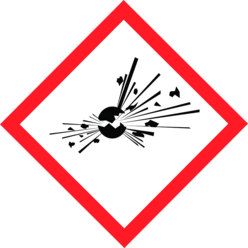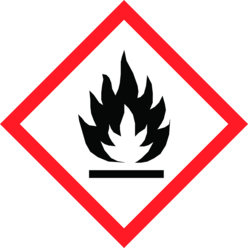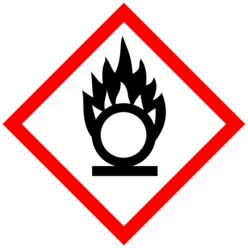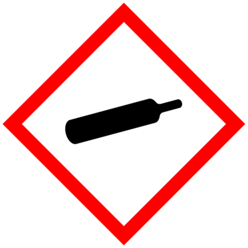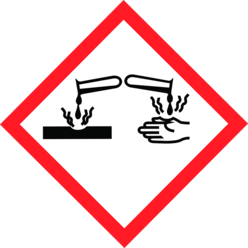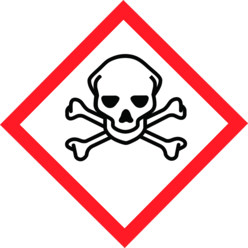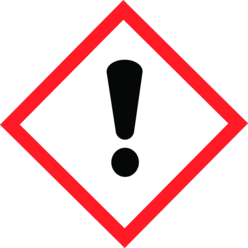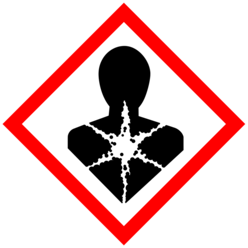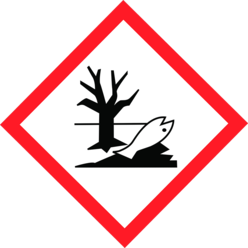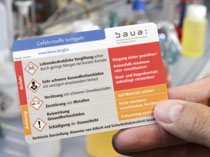A compact overview of the hazard statements
Hazard pictograms provide information on the hazards posed by hazardous substances, mixtures and products containing explosive materials. Signal words are used to describe the extent of the hazard.
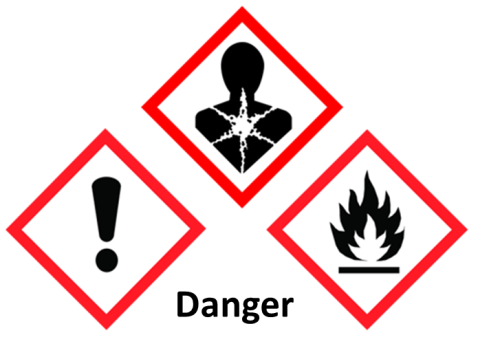
Pictograms are graphical representations, which consist of a symbol and additional graphical elements, such as a border, a background pattern or a background colour.
Annex I Part 1 no. 1.2 of the CLP Regulation specifies, that the hazard pictograms have to be diamond-shaped. In addition, a black symbol must appear on a white background in a clearly visible red frame.
Each hazard pictogram must occupy at least one fifteenth of the minimum area of the label, and shall not have an area below 1 cm² (the minimum area).
The nine hazard pictograms for the individual hazard classes, the differentiations of a hazard class and the hazard categories must correspond to the requirements of Annex V and Annex I, section 1.2 of the CLP Regulation. Regarding the symbols and the general format, they must also comply with the following examples.
The hazard pictograms have a coding system along similar lines to the hazard and safety information. All nine of the pictograms are sorted numerically from GHS01 - GHS09.
Number of required pictograms
The number of required pictograms should not overload the label. Therefore, according to Article 26, paragraph 1 of the CLP Regulation, it is necessary to follow a specific ranking order:
- If labelling with "GHS01" is required, the use of "GHS02" and "GHS03" is optional
- If labelling with "GHS06" is required, "GHS07" does not appear.;
- If labelling with "GHS05" is required, "GHS07" for skin and eye irritation does not appear.
- If labelling with "GHS08" in combination with H334 (Resp. Sens. 1, 1A, 1B) is required, "GHS07" does not appear in conjunction with H317 (Skin Sens, 1, 1A, 1B), H315 (Skin Irrit. 2) or H319 (Eye Irrit. 2).
- If labelling with "GHS02" or “GHS06” is required, the use of "GHS04" is optional.
Information on signal words
The signal word is the part of the label that states the extent of the hazard. Its purpose is to notify the reader of the label of a potential hazard. Differentiation is made between two hazard levels:
- Danger: Signal word for severe hazard categories
- Warning: Signal word for less severe hazard categories
The CLP Regulation stipulates which signal word is to be assigned and when. The hazard communication tables in Annex I, parts 2 to 5 of the CLP Regulation, detail the required signal words for the individual hazard categories.
Please note the following:
If the classification shows that a signal word should be assigned several times, it will appear only once on the label. If the signal word "Danger" is used, the signal word "Warning" does not appear.
This table provides an overview of the nine hazard pictograms:
Physical hazards
Symbol GHS01: Exploding bomb
| Pictogram | Hazard class and hazard category |
|---|---|
GHS01
| Section 2.1
Unstable explosives Section 2.8Self-reactive substances and mixtures, Types A, B Section 2.15Organic peroxides, types A, B |
Symbol GHS02: Flame
| Pictogram | Hazard class and hazard category |
|---|---|
GHS02
|
Section 2.2 Flammable gases, hazard categories 1A, 1B Section 2.3 Aerosols, hazard categories 1, 2 Section 2.6 Flammable liquids, hazard categories 1, 2, 3 Section 2.7 Flammable solids, hazard categories 1, 2 Section 2.8 Self-reactive substances and mixtures, Types B, C, D, E, F Section 2.9 Pyrophoric liquids, hazard category 1 Section 2.10 Pyrophoric solids, hazard category 1 Section 2.11 Self-heating substances and mixtures, hazard categories 1, 2 Section 2.12 Substances and mixtures, which in contact with water, emit flammable gases , hazard categories 1, 2, 3 Section 2.15 Organic peroxides, Types B, C, D, E, F Section 2.17 Desensitised explosives, hazard categories 1,2,3,4 |
Symbol GHS03: Flame over circle
| Pictogram | Hazard class and hazard category |
|---|---|
GHS03
|
Section 2.4 Oxidising gases, hazard category 1 Section 2.13 Oxidising liquids, hazard categories 1, 2, 3 Section 2.14 Oxidising solids, hazard categories 1, 2, 3 |
Symbol GHS04: Gas cylinder
| Pictogram | Hazard class and hazard category |
|---|---|
GHS04
| Section 2.5Gases under pressure:
|
Symbol GHS05: Corrosion
| Pictogram | Hazard class and hazard category |
|---|---|
GHS05
| Section 2.16Corrosive to metals, hazard category 1 |
Specific features of physical hazards
No pictogram is necessary for the following classes and categories of physical hazards:
-
Section 2.1
Explosives of Division 1.5 -
Section 2.1
Explosives of Division 1.6 -
Section 2.2
Flammable gases, hazard category 2 -
Section 2.3
Aerosols, hazard category 3 -
Section 2.8
Self-reactive substances and mixtures, Type G - Section 2.15
Organic peroxides, Type G
Health hazards
Symbol GHS06: Skull and crossbones
| Pictogram | Hazard class and hazard category |
|---|---|
GHS06
|
Section 3.1 Acute toxicity (oral, dermal, inhalation), hazard categories 1, 2, 3 |
Symbol GHS05: Corrosion
| Pictogram | Hazard class and hazard category |
|---|---|
GHS05
|
Section 3.2 Skin corrosion, hazard categories 1, 1A , 1B, 1C Section 3.3 Serious eye damage, hazard category 1 |
Information on labelling with the "Corrosion" symbol
In the case of substances or mixtures, which are toxic if inhaled, GHS05 can also be used in addition to GHS06, if the inhalation data indicate that the toxicity is based on a corrosive effect and EUH071: "Corrosive to the respiratory tract" applies.
Symbol GHS07: Exclamation mark
| Pictogram | Hazard class and hazard category |
|---|---|
GHS07
|
Section 3.1 Acute toxicity (oral, dermal, inhalation), hazard category 4 Section 3.2 Skin irritation, hazard category 2 Section 3.3 Eye irritation, hazard category 2 Section 3.4 Skin sensitisation, hazard categories 1, 1A, 1B Section 3.8 Specific Target Organ Toxicity (single exposure), hazard category 3:
|
Symbol GHS08: Health hazard
| Pictogram | Hazard class and hazard category |
|---|---|
GHS08
|
Section 3.4 Respiratory sensitisation, hazard categories 1, 1A, 1B Section 3.5 Germ cell mutagenicity, hazard categories 1A, 1B, 2 Section 3.6 Carcinogenicity, hazard categories 1A, 1B, 2 Section 3.7 Reproductive toxicity, hazard categories 1A, 1B, 2 Section 3.8 Specific Target Organ Toxicity (single exposure), hazard categories 1, 2 Section 3.9 Specific Target Organ Toxicity (repeated exposure), hazard categories 1, 2 Section 3.10 Aspiration hazard, hazard category 1 |
Specific features of health hazards
No pictogram is necessary for the following category of health hazards:
- Section 3.7
Reproductive toxicity, effects on or via lactation, additional hazard category - Section 3.11
Endocrine disruption for human health (category 1 and 2)
Environmental hazards
Symbol GHS09: Environment
| Pictogram | Hazard class and hazard category |
|---|---|
GHS09
| Section 4.1Hazardous to the aquatic environment
|
Specific features of environmental hazards
No pictogram is necessary for the following environmental classes and categories:
- Section 4.1
Hazardous to aquatic environment - Long-term hazard categories: Chronic 3, Chronic 4 - Section 4.2
Endocrine disruption for the environment (category 1 and 2) - Section 4.3
Persistent, Bioaccumulative and Toxic or Very Persistent, Very Bioaccumulative properties - Section 4.4
Persistent, Mobile and Toxic or Very Persistent, Very Mobile properties
Other hazards
Symbol GHS07: Exclamation mark
| Pictogram | |
|---|---|
GHS07
| Section 5Hazardous to the ozone layer, hazard category 1 |
